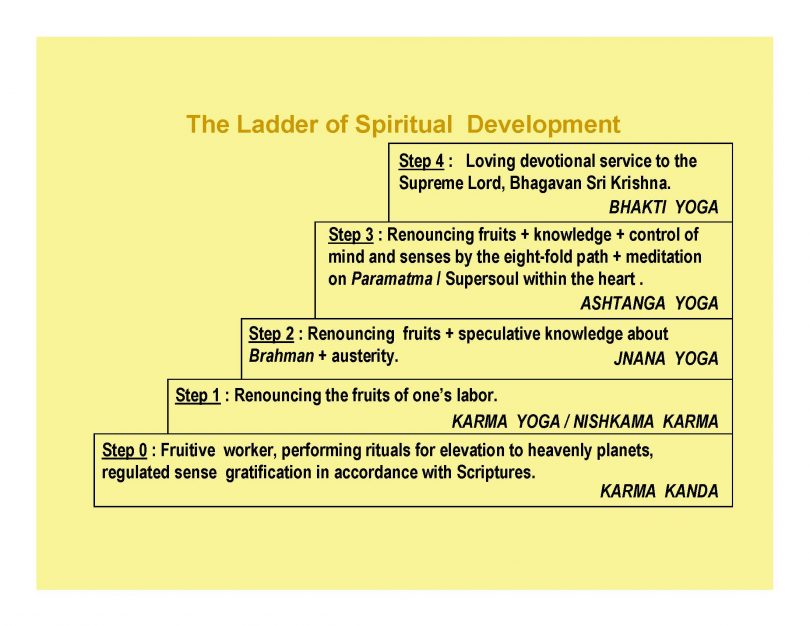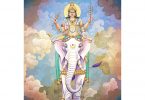Bhagavad-gita Chapter 12.8 to BG 12.12 offers us a sequence of elevation to perfection. The Yoga Ladder similarly offers us such a sequence.
Q. 1. How do these two descriptions compare?
Q. 2. It seems that there is a discrepancy between the two lists regarding where in sequence one places karma-yoga. Can you explain?
Answer by Romapada Swami: Different things, Krsna consciousness included, can be viewed from different angles. Depending on the angle of viewing something, descriptions may differ even of the same object.
Both the sequence given by Krsna in BG 12.8 to BG 12.12 and the Yoga Ladder found in the purport to BG 6.47 (see below) are offering a perspective on the same thing: Yoga, or the Systems of Yoga. Let us look closely at these two perspectives on Yoga.
Stages of Bhakti, Devotion to Krsna
Krsna’s description in Chapter 12 focuses primarily remembrance of Him, and upon the goal of fully and spontaneously remembering Him. He then offers stages or degrees of remembrance of Him, which can be seen as stages on the way to the attainment of that goal.
These stages of remembrance of Krsna are framed within specific yoga processes. Progress evolves as follows –
a) Discerning matter from spirit by Knowledge (impersonal process)
b) Meditating upon the impersonal feature of the Supreme (note carefully the first verses of this chapter, BG 12.1 to BG 12.3)
c) Sacrificing fruits of work unto Visnu, the Supersoul
1) sakama karma-yoga (sacrifice some fruits unto Visnu, but still attached to one’s activity and to some extent to to the fruits as well)
2) niskama karma-yoga (more complete in attachement to Visnu)
d) becoming attached to Krsna by regulations of viddhi sadhana bhakti
e) uninterrupted remembrance of Krsna.
The Yoga Ladder
The focus of the Yoga Ladder is Detachment from Matter, as well as one’s Attachment to a particular aspect of the Supreme (Brahman, Paramatma and Bhagavan). In bhakti, one cultivates attachment to Bhagavan by service. In astanga yoga, one becomes attached to the Paramatma feature. In Jnana yoga, one become attached to the Brahman feature. In Karma yoga, one is trying to become detached enough from matter that one can free one’s intelligence from the encumbrance of worldliness such that discerning the spiritual realm can be effective.
Here is the relevant passage from Srila Prabhupada’s purport in BG 6.47:
“The culmination of all kinds of yoga practices lies in bhakti yoga. All other yogas are but means to come to the point of bhakti in bhakti-yoga. Yoga actually means bhakti-yoga; all other yogas are progressions toward the destination of bhakti-yoga. From the beginning of karma-yoga to the end of bhakti-yoga is a long way to self-realization. Karma-yoga, without fruitive results, is the beginning of this path. When karma-yoga increases in knowledge and renunciation, the stage is called jnana-yoga. When jnana-yoga increases in meditation on the Supersoul by different physical processes, and the mind is on Him, it is called astanga-yoga. And when one surpasses the astanga-yoga and comes to the point of the Supreme Personality of Godhead Krsna, it is called bhakti yoga, the culmination. Factually, bhakti-yoga is the ultimate goal, but to analyze bhakti-yoga minutely one has to understand these other yogas. The yogi who is progressive is therefore on the true path of eternal good fortune. One who sticks to a particular point and does not make further progress is called by that particular name: karma-yogi, jnana-yogi or dhyana-yogi, raja-yogi, hatha-yogi, etc. If one is fortunate enough to come to the point of bhakti-yoga, it is to be understood that he has surpassed all other yogas.”
Thus, the Yoga Ladder traces detachment from matter, and consquent progressive attachement to Brahman, Paramatama and finally Bhagavan.
Stages of Bhakti, Devotion to Krsna, in terms of Remembrance of Him
Remembrance of Krsna can be stated as the goal in bhakti, since all the rules and regulations in bhakti are to assist our remembrance of Krsna. Favorable and full absorption in and remembrance of Krsna is practically the same as love for Krsna. That remembrance, which is done by injuction in vaidhi bhakti (BG 12.9), is done spontaneously in raga marg, and ultimately in love for Krsna (BG 12.8).
To rise to the platform of full rememberance of Krsna, Karma yoga on both levels (namely niskama and sakama karma-yoga) is described in BG 12.10. In the previous text 9, one remembers Krsna through practices of vaidhi bhakti, such as following the morning program and watering tulasi.
In 12.10, which seems to describe Karma yoga, one’s main attachment can be categorized as either [1] to the work (niskama); or [2] to the work and to its fruit (sakama). Those two, as described in 12.10, purify one so that one can remember Krsna, for in karma yoga, one’s mind will tend to be focused on the element (either the work or the fruit) that one is attached to.
A higher stage of working than the karma yoga described in 12.10, is working with bhakti, with attachment to and remembrance of Krsna. This is describes in Bg. 18.57: “In all activities just depend upon Me and work always under My protection. In such devotional service, be fully conscious of Me.”
This clearly involves a deeper stage of surrender, which is bhakti, and which is higher than karma yoga. Such a surrendered devotee constantly remembers his master, as Srila Prabhupada describes in his purport to that text:
“When one acts in Krsna consciousness, he does not act as the master of the world. Just like a servant, one should act fully under the direction of the Supreme Lord. A servant has no individual independence. He acts only on the order of the master. A servant acting on behalf of the supreme master is unaffected by profit and loss. He simply discharges his duty faithfully in terms of the order of the Lord. Now, one may argue that Arjuna was acting under the personal direction of Krsna but when Krsna is not present how should one act? If one acts according to the direction of Krsna in this book, as well as under the guidance of the representative of Krsna, then the result will be the same. The Sanskrit word mat-parah is very important in this verse. It indicates that one has no goal in life save and except acting in Krsna consciousness just to satisfy Krsna. And while working in that way, one should think of Krsna only: “I have been appointed to discharge this particular duty by Krsna.” While acting in such a way, one naturally has to think of Krsna. This is perfect Krsna consciousness.”







